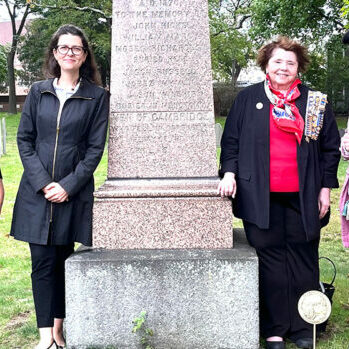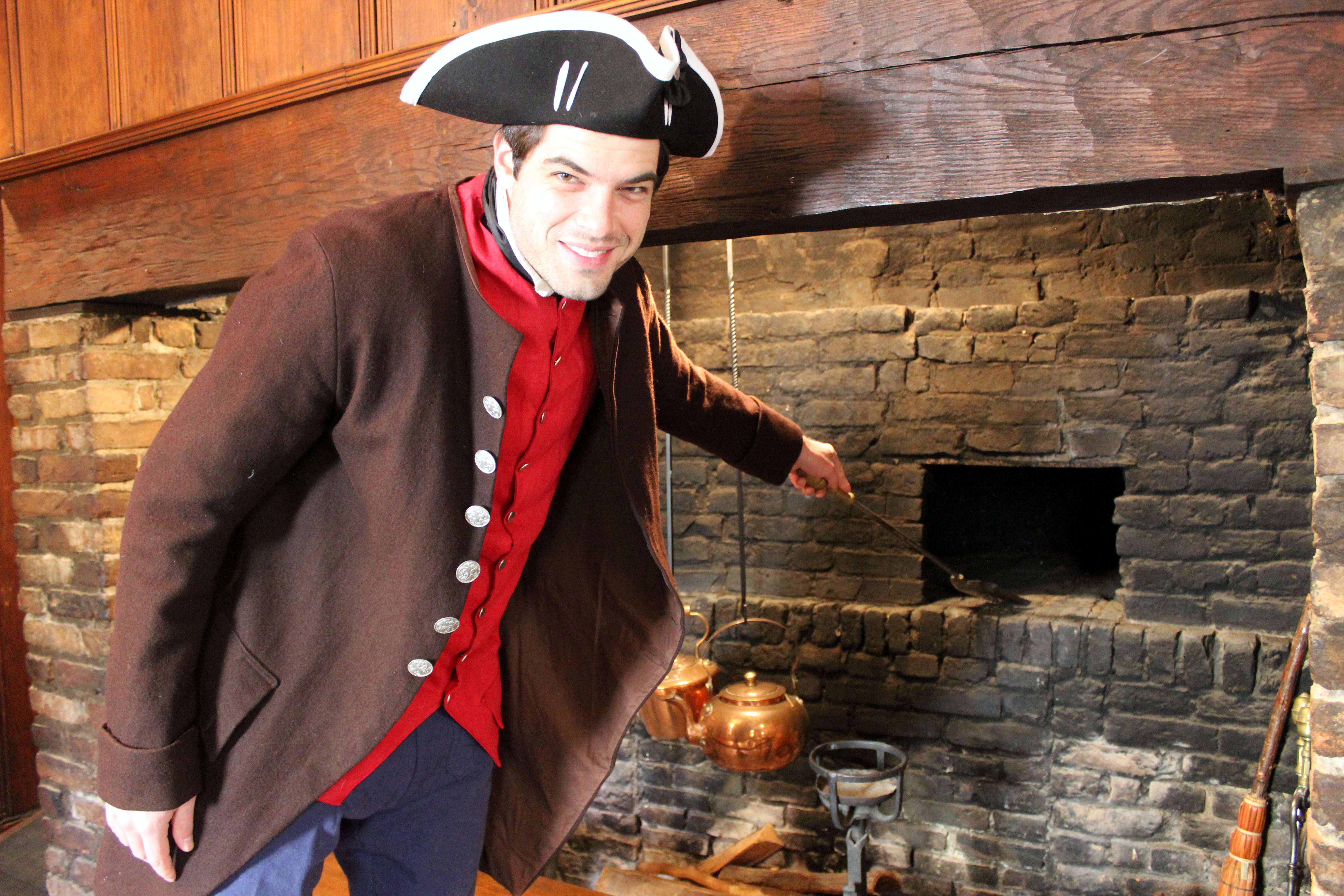
The Revolution’s 250th anniversary approaches, demanding answers to how we commemorate
Above image: History Cambridge executive director Marieke Van Damme, second from left, and program manager Beth Folsom, left, at the Oct. 6 installation of a marker at the grave of John Hicks in the Old Burying Ground in Cambridge with representatives from the Daughters of the American Revolution and the Boston Tea Party Ships & Museum. (Photo: History Cambridge)
Over the next several years, Cambridge will mark the 250th anniversary of a number of significant events in the lead-up to and early days of the American Revolution. As we prepare for these anniversaries, History Cambridge ponders the questions of how we should commemorate our city’s role in the Revolution, its continuing relevance to the Cambridge of today and the stories and perspectives that have not traditionally been celebrated or shared.
As we approach the anniversary of the Boston Tea Party this December, several local organizations have worked to install markers at the graves of known participants in that protest. This month, History Cambridge joined representatives from the Boston Tea Party Ships and Museum, Revolution 250, the Daughters of the American Revolution and the Cambridge Historical Commission for a ceremony to install one such marker at the grave of John Hicks in Cambridge’s Old Burying Ground. Hicks was in many ways an “ordinary” Cantabrigian – a man of modest means who participated in the destruction of the tea in Boston Harbor on Dec. 16, 1773, but talked little about his participation for most of his life. He was active in the Patriot cause and most likely a member of the Sons of Liberty, although he was not part of its upper echelons. He and two other Cambridge men were killed less than two years later in an exchange of fire with British soldiers retreating from the Battle of Lexington and Concord.
Cambridge’s first significant anniversary comes next year, in 2024. On Sept. 1, 1774, Cambridge residents responded to the news that Gen. Thomas Gage, royal governor of the Province of Massachusetts Bay, had ordered the removal of gunpowder from a magazine (a powder storage house) in what is now Somerville by the British troops stationed in Boston. The resentment that area residents felt in the wake of the Coercive Acts – a controversial series of laws intended to punish the rebellious Bostonians for the Boston Tea Party of 1773 – caused them to channel their anger at Gage and his soldiers. Because these 1774 Coercive Acts effectively closed the Port of Boston and dissolved the colonial government, replacing it with a royally appointed governing body, Cambridge residents and their neighbors feared a loss of autonomy and what they considered their essential rights as subjects of the British Crown.
By the following morning (Sept. 2, 1774), approximately two and a half times the population of Cambridge – 4,000 people – had gathered on Cambridge Common. Patriot leaders used the power of the assembled crowd to protest their grievances. They soon marched down Brattle Street and surrounded Lt. Gov. Thomas Oliver’s house, demanding his resignation. He stepped down, saying: “My house in Cambridge being surrounded by about four thousand people, and in compliance with their commands, I sign my name.” In the months following the Powder Alarm, many of the Loyalists (or Tories) of Cambridge left, first moving to Boston, which was much less volatile because of a larger British military presence.
Cambridge’s biggest claim on the Revolutionary legacy will be celebrated in July 2025, when the city will mark the 250th anniversary of George Washington’s arrival to take command of the Continental Army. While we know that Washington did, indeed, live in Cambridge from July 1775 to April 1776, in the Brattle Street home of John Vassall Jr. (whose Loyalist sympathies led to its seizure and reassignment as Washington’s headquarters), many of the myths that have sprung up around the general’s time in the city have served to bolster Cambridge’s importance to the Revolutionary struggle. It has been widely proclaimed that Washington took command of the army under a large elm tree on Cambridge Common, which has come to be known as the Washington Elm. Although it is probable that the assumption of command did take place on the Common, where many of the soldiers were encamped and where the public could gather to watch the ceremony, the role of what would become the sacred elm tree is highly questionable, most likely springing from a 19th century “discovery” of a colonial diary entry that was in fact fictional. But the myth of the Washington Elm persists (see this column next week for an exploration of the Washington Elm legacy on the 100th anniversary of its fall).
As we prepare for this series of significant anniversaries on the local, regional and national levels, what lessons does the Revolution have to teach us today? Why should Cantabrigians in the 21st century care about – much less celebrate – the events of 250 years ago? How is the Revolution and its legacy important to us now, in this moment, and how can we use the marking of these anniversaries to not only commemorate the past, but to take stock of the present and shape the future of our city and beyond? History Cambridge is exploring these questions as we move into the 250th anniversary season, and we want to hear from you. Does the Revolution matter to you? What, if anything, can it teach us today? Who and what has been left out of previous commemorations, and how can we ensure that we tell a more complete version of the Revolutionary experiences of all of Cambridge? Let us know your thoughts at info@historycambridge.org; we look forward to making (Revolutionary) history with you.
Beth Folsom is programs manager for History Cambridge.
This article was originally published in our “Did You Know?” column in Cambridge Day.



